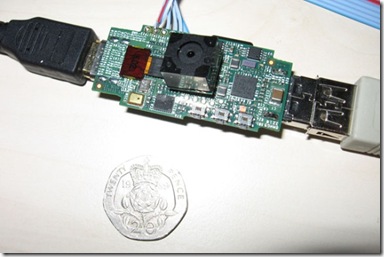700MHz processor, 256MB of RAM. It doesn’t seem that long ago since I was running a desktop PC like that. However, these are the specs of a new keyring-sized computer to be released by a UK not for profit company. They hope to be able to sell it for $25 dollars a pop, and best of all, it runs Linux.
The idea is that this small unit can output 1080p video to a digital television. Permanent storage is provided via a memory card slot, and IO (keyboard and mouse) requires a USB hub. In other words, it’s a small but functionally complete computer.
On the website and elsewhere, the designers are discussing deploying it as an Internet access terminal or some sort of set-up to encourage young people to take an interest in computer programming. One of the big names backing the project, David Braben, got started by experimenting with with the home computers of the early 80s, which typically came with a built-in programming language.

For the moment the specs are tentative, but the device will use a ARM based system-on-a-chip. ARM itself doesn’t actually fabricate CPUs, it develops technology and then licenses it, and the chip is a Broadcom BCM2763. The company website indicates that this chip was designed with mobile phones in mind.
As for simple MIPS/FLOPS performance, I doubt that this processor is competitive with say, a Pentium III running at 700MHz, as modern ARM processors in desktop applications tend to be power-saving rather than powerhouses. However, bear in mind that this thing was intended to be the heart of a modern phone with camcorder and mobile gaming features, and as such, it has some impressive video processing specs. The graphics facilities include OpenGL ES, a standard for rendering 3D graphics on mobile devices, and it can also decode H.264 video on the fly. So, the relatively low processing power need not hinder the usefulness of this device in its intended role. My guess is that KDE 4 wont be the go-to choice as a front end.
We’ve all seen low cost, low power projects like this come and go in the past. To achieve the price that the project is aiming for, it will have to achieve manufacturing volume. In its favor, although there will be a buy-one-give-one scheme of some sort, early indications are that it won’t be the only way of getting one. I can think of one high profile project with similar aspirations that torpedoed itself by making it very difficult to buy a machine, despite the considerable demand. That project has subsequently never been able to hit its target unit cost due to to insufficient manufacturing volume.
It’s clear that if a device like this could be brought to market for anything like the intended price, it could do a lot to attack the global digital divide. At the same time, I’m sure that lots of hobbyists who already have a computer, could find dozens of uses for a device like this. When they become available, I know I’ll be getting one.
The Raspberry Pi website.
David Braben talks about the project.
